Destination Dubai
Cemtech Middle East & Africa 2015 was held in the Grand Hyatt Dubai, UAE, on 8-11 February, with more than 270 delegates participating in this three-day conference and exhibition. Covering worldwide cement industry trends and manufacturing technology with a well-researched speaker programme and senior participants from over 50 cement companies, Cemtech remains the most relevant cement conference series in the industry calendar.
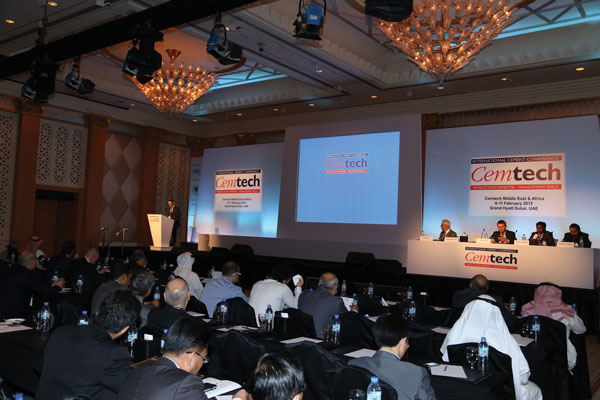
Cemtech Middle East and Africa gets underway at the Grand Hyat Hotel, Dubai, UAE,
before an international audience of 270 cement industry specialists
Cemtech MEA 2015 took place against the backdrop of the global oil price collapse, which saw oil prices halve from US$100/barrel in 2014 to less than US$50/barrel by February 2015. This dramatic development provided a rich seam for discussion in the opening sessions of the meeting which dealt with the impact of falling prices on the world economy and, in particular, the Gulf cement sector.
Welcoming delegates to the meeting, Thomas Armstrong, managing editor of International Cement Review, opened the session with the main themes facing the cement sector, highlighting expectations of an expansion in global demand growth in 2015, which is expected to edge ahead by 4.5 per cent. The sliding oil price, he argued, would have both positive and negative impacts on global cement production and consumption. Countries that are net energy importers, notably the USA, the euro area, India, Turkey and Japan, would benefit from low oil prices which would free up funds for investment and increased consumer spending. On the other hand, energy exporters will be exposed to the downside risks: “In the major oil-exporting economies, notably in the GCC, lower oil prices will result in reduced revenues for governments whose budgets will have to be tightened,” highlighted Mr Armstrong. “Expenditure on public construction and infrastructure development will inevitably be trimmed, resulting in more modest cement consumption trends," he added.
A bumpy ride
Speaking next, Yuri Serov of Morgan Stanley (UK) provided his eagerly- anticipated world review of cement market trends, characterising the global economic recovery as “bumpy, below-par and brittle” or “BBB”. The global economies are out of sync, with many countries in different stages of their respective cycles, Mr Serov noted. However, overall cement consumption growth (excluding China) is gathering pace from a recent low point in 2014 towards around an estimated 3.3 per cent and 4.8 per cent in 2015 and 2016, respectively.
Mr Serov’s presentation also attempted an ambitious 25-year forecast to explore how the world might look like in 2040. While admitting that long-range forecasts are inherently uncertain, the analysis highlighted some key trends that cement producers should be monitoring as they evolve their businesses.
By 2040, China and India are each expected to make up just over 20 per cent of global demand, compared to 60 per cent for China and six per cent for India currently – a significant transition. Sub-Saharan Africa is set for the biggest breakthrough, increasing to 10 per cent of total demand from negligible levels now. Meanwhile, developed markets are set to grow at a rate of less than one per cent over the period. Food for thought!
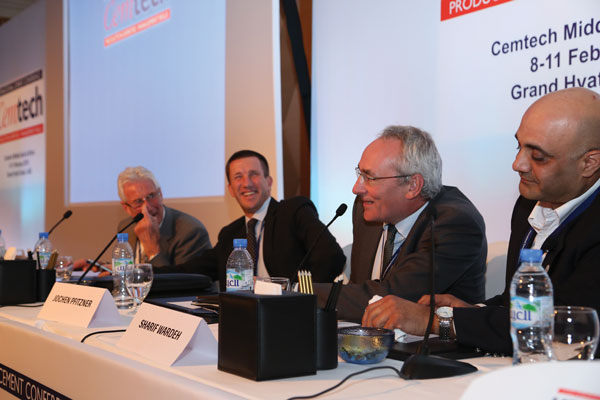
Question time: speakers answered a variety
of questions from the conference floor
Hettish Karmani of Global Investment House (Kuwait) returned to the theme of the oil crisis and explained that while the impact of the price crash will push GCC government budgets into deficit in 2015, all countries in the region should weather the crisis by relying on accumulated reserves. Meanwhile, oil prices are expected to recover strongly over the next two years to US$80/barrel, a level that is considered sustainable going forward.
Crucially for the cement industry in the GCC, construction activity will be largely protected by governments keen to proceed with long-term development plans, which also support efforts to diversify their economies away from oil dependence to a broader-based growth paradigm.
Turning to the UAE, Harpreet Duggal of Black Rock Cement (UAE) noted that the IMF has already reduced economic growth projections by one per cent. However, he argued that the biggest downside risk to future growth will be investor sentiment in the real estate sector, rather than the fundamental impact of the oil price crash on the domestic economy.
African outlook
Moving on to Africa, Tony Hadley, Baobab Advisory (France) and former CEO of Dangote Cement, Nigeria, gave an insightful presentation into the prospects and opportunities for cement sector investors across the continent. Resolutely positive about the long-term growth prospects, Mr Hadley warned that investors in these regions need to understand the cycles and dynamics of these markets on a country-by-country basis. Markets can reach plateaus, where decades of strong advances are followed by decades of pedestrian growth, as is the case of Morocco (where, additionally, new entrant CIMAT has placed further pressure on the incumbents), undermining investment appeal. In other markets government intervention can rapidly alter the commercial attractiveness of a market, with one example being Egypt, which has seen gas prices rise from US$0.70/mBtu to US$60/mBtu since the start of subsidy removal.
In sub-Saharan Africa higher levels of anticipated growth offer investors an ‘insurance policy’ for all the other risks inherent in this emerging region. These are clearly illustrated by the example of Nigeria, which in 2014 experienced the effects of the oil price shock, currency devaluation, economic uncertainty and political insecurity in the run-up to the election.
New plant construction
Turnkey plant supplier Polysius SAS/ThyssenKrupp (France) is a company with an impressive track record in the MENA region. Luc Rudowski provided a tour of several recently- completed projects, including the upgrade at Tunisia’s Ciments de Bizerte and a string of six new 0.5Mta grinding plants delivered in Guinea, Burkina Faso, Côte d'Ivoire, Cameroon, Gabon and Congo for CIMAF (Morocco). Polysius is currently working on the new 6000tpd line for Société des Ciments d’Aïn El Kebira (Algeria).
Philippe Zacca, CFO, Guinée Industries Ciments, presented the company’s new 0.85Mta clinker grinding facility commissioned in February 2013. Guinea, the largest exporter of bauxite in the world, is recovering from the ebola epidemic that severely impacted the country in 2014 but is nevertheless a resource-rich nation with great development potential.
Cemtech Technical Workshop |
|
| The Middle East, and particularly the GCC countries, have long relied on expatriate workers to populate their industries and grow their economies. This model is now seen as unsustainable and many countries in the region, most notably Saudi Arabia, are placing strict requirements on companies to employ a minimum quota of local workers. Improved levels of education and specialist training are required, and nowhere more so than in the cement industry. |
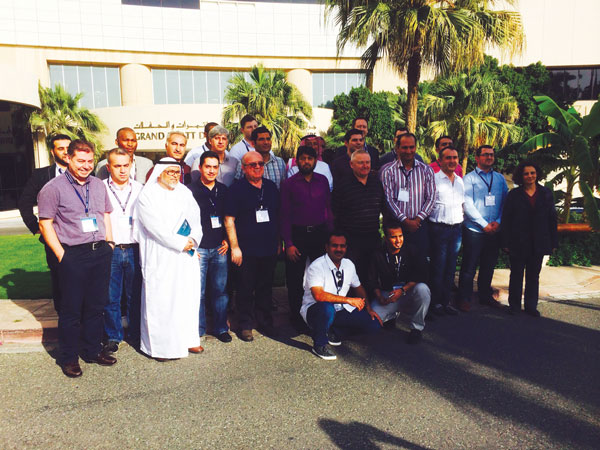 |
| Seeking to respond to this need, Cemtech Technical Workshop was organised in parallel with Cemtech MEA 2015 and proved a resounding success. A total of 26 engineers from six countries participated in the course, which was led by Dr Michael Clark and covered the fundamentals of cement manufacturing, before delving into practical strategies for plant optimisation. Using carefully-planned exercises alongside lectures and discussion, the course provided a unique opportunity for personal development and enhanced understanding of the entire cement manufacturing process. |
|
| The next Cemtech Workshop will take place in Bangkok, Thailand, on 22-24 June. For more information, see: www.Cemtech.com/Asia2015/Workshop | |
New markets for cementitious cements
Gareth Ward, previously CEO of Sunstate Cement in Australia and now MD of ZAG Asia Pacific & Middle East, explored current trends in worldwide supply and demand of supplementary cementitious materials (SCMs), noting increasing demand for GGBFS and fly ash from end users, especially in Gulf countries. Global supply of SCMs is estimated at 500Mta worldwide but will be insufficient to meet demand in future, forcing end-users to plan strategically to secure their supply.
Jochen Pfitzner of Hawar Power Minerals (Qatar) explained the technical properties of SCMs and in particular, fly ash, which due to its spherical shape improves liquid concrete workability as well as providing increased durability of the final product and a lower CO2 footprint. These properties are making it an ideal product for utilisation in large infrastructure projects, especially in Qatar and increasingly in Saudi Arabia.
Sharif Wardeh of Beumer (UAE) completed the session with a highly visual presentation on bagging and palletising technology for Middle Eastern markets, where the company’s integrated solutions have become a standard across many plants.
Consulting the experts
Consultancy services for the cement industry are available for every conceivable need. Nouran Yaghchi of Whitehopleman Services (UAE) described the company’s specialist expertise in project monitoring greenfield plants, in particular those supplied by Chinese equipment suppliers.
Outsourcing of plant operation and maintenance (O&M) has become increasingly favoured in the cement industry, particularly by asset owners without experience in running cement plants. ASEC Engineering & Management (Egypt) is a leading supplier of this service and Howam Darwish explained how the company's O&M services are structured to offer cost-effective plant operations, as evidenced by its activities in several countries including Egypt, Saudi Arabia, Mozambique and Ethiopia.
Powerful milling
Grinding systems were comprehensively covered in the programme by two of the industry’s leading suppliers. Abdullah Bellafkih of Loesche (Germany) provided an overview of vertical roller mill (VRM) capabilities. In the Arabian Peninsula the company has 40 mills in operation, of which only 11 are for clinker grinding – a trend the company hopes to reverse.
Carsten Schoessow of Gebr Pfeiffer (Germany) looked back at the company’s impressive 150-year history, which includes manufacturing the first VRM for clinker grinding (in 1979) and the world’s biggest VRM for clinker grinding at Australia's Port Kembla (in 2011).
WHR comparison
Dr Arif Bashir, DG Khan (Pakistan), provided an important technical paper comparing the performance of a standard water/steam circuit waste heat recovery system supplied by Kawasaki (Japan) at one plant with the performance of the Kalina cycle recovery system – the first of its kind – supplied by FLSmidth in 2013 at a second plant. The Kalina system, which uses ammonia rather than water for the generation of the steam and is more suited to low-temperature power generation, was successfully generating 4.3MW net power but at a higher cost than the conventional WHR system. The Kalina system will undergo further modifications to improve efficiency and DG Khan expects it to reach its rated capacity of 8.6MW later in 2015.
An optimised case study
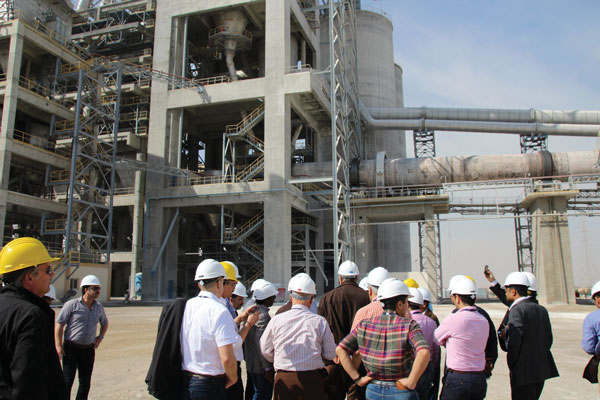
Delegates had the opportunity to visit JK Cement Ltd’s
0.6Mta white /1Mta grey cement works in Fujairah
Juliano Arantes of ABB (Switzerland) presented a case study on a new advanced process control (APC) installation now operating at Votorantim Cimentos’ plant at Hasanoglan in Turkey. APC uses available measurements to initiate automatic adjustments to the plant to increase efficiency at a given quality, making the process more efficient, cost effective and reliable. ABB’s new Expert Optimizer 8.0 controls kilns, calciners, coolers and mills, but also can be used to manage other plant systems, such as alternative fuels.
Fuelling changes
Dr Jayanta Saha of Penta (India) gave an expert overview of fuel economics and the steps required to convert from gas to solid fuel, including understanding coal and petcoke variability and process issues, plus storage, grinding and firing considerations.
Important case studies and new technologies for alternative fuels featured in three superb presentations on the second day of the conference. Getachew Okbay from the Messebo Cement Factory in Ethiopia began with an update on a biomass project at his plant in the north of the country at Mek’ele. The objective is to replace 40 per cent of imported coal with biomass energy from sesame husks, and a targeted fuel reduction cost of US$4/t clinker. Providing the expertise for this project is the A TEC Group (Austria), and the company's Michael Suppaner explained that the savings of the project would result in a payback of less than two years.
Sebastian Frie of ThyssenKrupp Industrial Solutions AG presented the latest operational results from the PREPOL Step Combustor. The first system has been installed at Holcim Lägerdorf (Germany) and after a rapid commissioning process is already operating beyond expectations. The system enables coarse alternative fuels to be burned in the calciner and thereby offers significant savings by reducing the need for alternative fuel preparation.
Kilns, precalciners and baghouses
Continuing with co-processing, Tahir Abbas, Cinar (UK), discussed how computer simulations and CFD modelling can be used to improve calciner geometry and identify optimum fuel injection points for alternative fuels.
Following this, an expert presentation was delivered by Eduardo Reis of Magnesita (Brazil) on the advantages of the Doloma brick for refractories, with useful information on how additions of zirconia (ZrO2) can improve thermal shock resistance while Magnesia (MgO) can offer greater corrosion resistance.
Yoann Picard of Iteca Socadei (France) highlighted the importance of using effective seals at the kiln inlet and outlet to prevent false air entering the process, preserve energy and offer production capacity savings, in some cases up to EUR0.5m per year. Iteca offer technology utilising interlocking graphite plates that provide a perfect kiln seal, lasting up to seven years with a typical payback of just 6-12 months.
Salvatore Gallo, Boldrocchi (Italy), presented a new baghouse filtration systems for improved emission control recently installed at Suez Helwan plant in Egypt. The unit is performing well, reducing dust emissions to 4.8mg/Nm3 and beating all guaranteed performance targets.
Greenfield Turkish plant
Jaber Malandi of Bedeschi (Italy) presented a case study of the Medcem cement plant in Turkey – and the largest in Europe with a recently-commissioned 10,500tpd clinker production line. The presentation focussed on the shiploader installed at the Yesilovacik Port with a capacity to load 40,000dwt vessels at 1400tph.
A cool end
Concluding the programme, Nick Sutherland of Solex Thermal Science (Canada) unveiled a novel cement cooling technology which can be used to reduce temperatures of freshly-milled cements to reduce lump formation or meet the lower temperatures required when using plastic cement bags. A simple operating principle is employed whereby cement flows slowly, vertically downward by gravity between water cooler plates cooling the cement from 80 to 40°C.
Exhibiting technologies
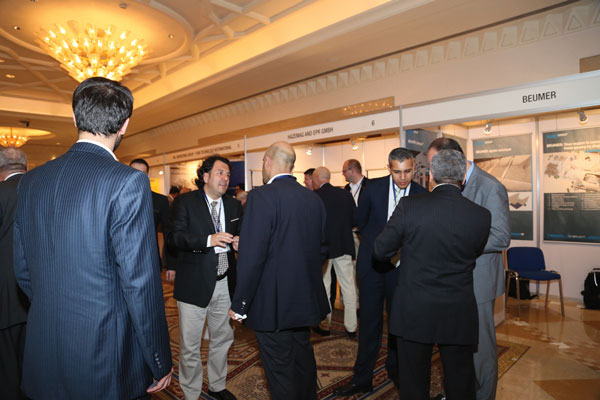
Delegates visit the vibrant exhibition with
many leading international suppliers present
If any part of the cement production process was not represented in the conference programme, then it was sure to be found in the equipment exhibition, which featured many of the leading equipment suppliers active in the region. From turnkey plant suppliers (Fives FCB, France) to crusher and mill manufacturers (Hazemag, Germany; Cemengal, Spain; Gebr Pfeiffer, Germany), bulk material handling (Bedeschi, Italy; Van Aalst Bulk Handling, Netherlands) and more, the exhibition provided the perfect forum for exploring technologies directly with the supplier.
Another successful conference
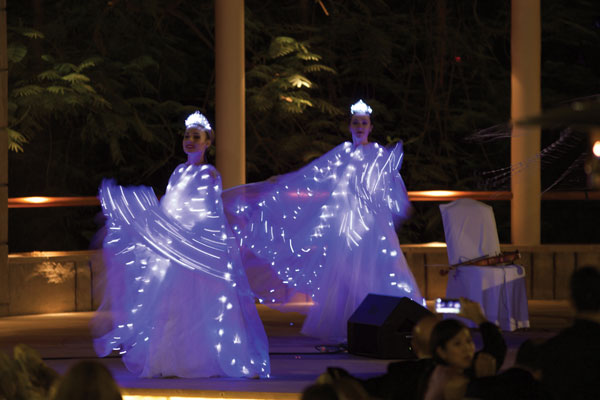
Entertainers at the Gala Dinner
Cemtech is not all about business. Putting delegates first by offering generous hospitality, including welcome dinners, lunches and evening receptions provides ample time for participants to interact beyond the conference and exhibition. This year the programme culminated in a wonderfully-staged Gala Dinner, complete with classical and modern Middle Eastern entertainment, and a luxurious dinner under the Arabian night sky.
For those staying an extra day, there was the chance to visit JK Cement Ltd’s dual white/grey cement works located at Fujairah. Currently producing white cement for global markets, this versatile plant has a white and grey clinker capacity of 1750tpd and 2800tpd, respectively.
From cement markets and trade through to cement production, Cemtech remains at the leading edge of information exchange for senior cement professionals worldwide. The next Cemtech Middle East & Africa conference take places in Dubai in February 2016. In the meantime, further meetings will be held in Thailand, Austria and the USA in 2015.
The unabridged version of this article was first published in International Cement Review, April 2015.

